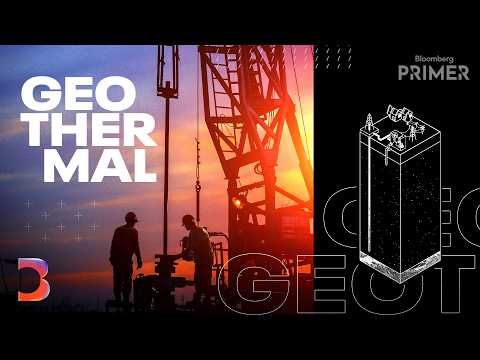The Big Business of Drilling Deep Into the Earth | Bloomberg Primer

(mysterious music) - [Narrator] The deepest hole ever dug on planet Earth is right here, in Northwest Russia. It's called the Kola Borehole. Scientists started drilling in 1970 to study the composition of the Earth's crust and presumably to see how deep they could go. Eventually, they reached a depth of almost 12 kilometers. That's roughly a third of the way through the Earth's crust on land. - It took 'em over 20 years to drill just because of the hard rock and that depth.
As they were drilling, there were these rumors that they were hearing voices down there, almost like, you know, the depths of hell. - [Narrator] In the mid-90s the project ran out of funding. The site was abandoned and the hole was sealed up. And the 12-kilometer record still stands, for now.
- 12 kilometers is not that far, right? And just think about that. We've actually never directly measured anything deeper than that. It truly is kind of the final frontier. - [Narrator] Well, okay, it's not like we have no idea what's down there.
Coal, oil, and natural gas covers 80% of global energy demand after all. But there's one resource under the Earth that's often overlooked and maybe undervalued. - Drill anywhere on the Earth, and if you go deep enough, you'll find hot rocks. And so, what you can do is turn that heat into power, electricity, and that's really geothermal energy. - [Narrator] Geothermal is the underdog of the energy industry. Generating just 0.3% of electricity worldwide
is mostly considered impractical outside of a few specific spots around the globe, but that's starting to change. - Geothermal energy opens up a new economic paradigm. Heat suddenly becomes a service and not linked to a commoditized fuel. - Hundreds of millions of dollars are pouring into startups aiming to tap the energy under our feet. - Geothermal is just too compelling to ignore. I like to say it's the largest source of clean energy on Earth.
- [Narrator] And today, companies are looking to go deeper than we've ever gone before, using new drilling technologies that do this to solid rock. But are their new technologies really up to the task? And can they avoid the Earth-shaking consequences when drilling goes deeply wrong? (crowd screaming) (upbeat intro music) (slow music) - Sure, are we just going on the tailgate? - Yeah. - Okay. - On the... - [Narrator] That fellow in the bucket hat is Jim Faulds.
With his crew of geology students, he's constantly on the hunt for new hotspots, collecting data that geothermal companies can use to expand their operations. (engine whirring) (drill rattling) - Like butter, baby. - [Narrator] They use methods like this heat probe to check subsurface temperatures to find the best spots to drill. (steam hissing) - Geothermal energy.
In a way, it's so simple. It's just the Earth's heat. It's always there. At least it will be there for another couple billion years.
Core is much, much hotter than the surface of the Earth, and there's sort of large convection cells that help to bring that heat up closer to the surface from deeper levels. The Earth produces enough geothermal heat in a given year. I think something like 10 times the amount of energy that just the United States needs in a given year. There are many areas on Earth that have relatively high levels of geothermal potential. - [Narrator] Countries like New Zealand, Indonesia, Turkey, and China all have plentiful geothermal resources. But Iceland is considered the true geothermal champ.
The country transformed its volcanic heat into an economic windfall. - Iceland was a developing country in the early 20th century until it tapped geothermal energy. And once it did, it was able to use that energy and convert it into industrial output and become a richer country. It is today one of the most developed countries in the world with a very high per capita income.
But there are many countries around the world that have access to geothermal power, but have yet to really tap it. For places like Kenya, they're at an early stage of development, but if they can access more geothermal power, they can have cheap, clean electricity that can be converted into economic output pretty quickly. (relaxing music) (car drones) - Sorry, guys. It's a bit noisy, because there are machines running, generator running, cooling system happening.
So, this point, steam is collected and sent to Sosian power plant. So, from this point, you can see a green line supplied to all of the units in the power plant. - [Narrator] This plant is operated by Sosian Energy, a relatively new player that raised $91 million to build the 35-megawatt facility. It taps into a hotbed of geothermal potential known as the Rift Valley. - This portion of the African continental shelf is actually separating from the rest of the continental shelf.
The area where we are today, we're at the bottom of that rift, and that is why it is called the Rift Valley. And because of this, the internal Earth heat that we're using, that heat is much more readily accessible, because the distance that we have to travel to tap into this heat is much lower than other areas in the world. - [Narrator] That lucky geography means that almost half of Kenya's electricity is generated from geothermal heat. - This plant generates electricity through what I call elaborate plumbing. These massive green pipes is what is delivering this steam from two to three kilometers deep.
It is directed into turbines, and those turbines convert the heat into electrical energy. That electricity is then transferred to the national grid. This country has a potential of up to 10 gigawatts of geothermal resource. And right, now we've barely tapped one gigawatt. So, we have a massive headroom that we need to exploit.
As a country, we can more than meet our national demand through just tapping into the geothermal resource. Industrialization does not happen on thin air, it requires electricity, and electricity needs to come from sustainable sources. And geothermal can be very central to that African industrialization story, because it is something that is available 24 hours a day, 365 days a year. - [Narrator] And that always on quality is very, very special in the world of clean energy. - Solar and wind are the two variable sources of renewable energy that have exploded with hundreds of billions of investment in recent years around the world, but they're at the whim of the weather. That means that when it's cloudy, solar panels don't generate optimally, and when air currents are still, turbines for wind power are also not in operation.
And geothermal, because it's available 24 hours, seven days a week, provides that reliability that investors are looking for in a grid. - [Narrator] So, on the surface, geothermal looks like an ideal energy source. Clean, dependable, good for another few billion years. But so far, it's only really worked in a few places. So, why exactly is that? Well, it turns out that geothermal power needs three very specific conditions. Heat, a reservoir of water, and a layer of porous rock.
You've got all three, you're in business. No water, no big deal. Many geothermal plants simply pull their own fluid down into the hot rock, but that rock really has to be porous.
If you can't get fluid flowing through the hot rock, you can't use the heat. Solid rock just won't work. So, outside of the places where the rocks are hot and full of holes, geothermal is a nonstarter. And that's why it only generates 0.3% of worldwide, putting it in the other wedge, the least cool wedge in the whole chart.
But a new class of startup is aiming to make the wedge a whole lot bigger. (text whooshing) - Fervo Energy is a next generation geothermal developer. We've developed new technology that makes geothermal work in far more places.
- [Narrator] To do that, Tim is borrowing technology from the oil and gas industry, where he used to work. - Yeah, I didn't plan this, but the office building you can see right behind me was where I started my career. Just through the window there at BHP's Houston offices, and started my career working as a drilling engineer in South Texas. So, they just started getting into the shale boom. The light bulb went off for me that all the technological advancements that I was seeing in my day-to-day career in oil and gas were gonna be just as transformative for geothermal drilling as they were for oil and gas drilling.
- [Narrator] Hydraulic fracturing, fracking, is a process of injecting highly pressurized liquid into underground rock, opening up gaps where none existed before to then extract oil and gas. Combined, fracking with geothermal instead, and you've got enhanced geothermal. - [Tim] We create new fractures in the rock that essentially turns the subsurface into a giant heat exchanger radiator, and we pump cold water down the injection wells, flow over to our production wells, where they come back up to the surface picking up the heat, and then we capture that heat at the surface and use it to generate electricity. - [Narrator] Now, we've gone from three conditions to just one: hot rocks.
And that could open things up a lot. - Historically, geothermal was limited to very specific geology. So, the only places that you would see a geothermal power plant today would be in this certain hot spot in Northern California, some plants across Northern Nevada. What this red map is showing is that thanks to the developments of enhanced geothermal system technology, much more of the country is developable. So, even in today's cost structure, you can think about things that are in the reddish and orangish color and some of the yellow color as already being cost effective. So, we're envisioning, you know, more than 100-fold increase in the amount of geothermal that you can get, and if you can replicate this for really any country.
- [Narrator] Fervo debuted its technology with a small plant in Nevada in 2023. They're now building a full-scale power plant in the mountains of Utah. - All 400 megawatts will be online in 2028, and a 400-megawatt project is quite large. When we bring this plant online, I'll be responsible for roughly 10% of all the power generated in the state of Utah. - [Narrator] Producing that much clean electricity is a big opportunity, and others are taking notice.
An hour south of San Antonio, Texas, in a region dense with fracked gas wells, another enhanced geothermal startup, Sage Geosystems, is building a test plant. - So, yeah, I spent 35, 36 years in the oil and gas industry. It was all with Shell. I really wanted to be in the energy transition, and geothermal is that clean energy that best leverages my skillset.
- One of the most exciting parts about geothermal energy is that it provides the opening for a just transition for people who work in the fossil fuel industry. A lot of people who are currently engaged in geothermal energy come from oil drilling, and it requires the same skillset of geophysicists and roughnecks who are willing to do hard labor of drilling and have a knowledge of the Earth's crust and how to bore beneath it. - [Cindy] It's 15% HCL, correct? - I dunno.
(Cindy laughs) (Brianna laughs) - [Cindy] You're supposed to just say, "Yeah, of course it was." - Oh, yeah, sure, definitely. - We have 537 variables. My daughter definitely had an impact on me moving into geothermal. She worked for Sage before I worked for Sage. She likes to remind me of that.
- I was like, "Yeah, you should come over because it's way funner over here." You know, oil and gas is kinda boring and you know what you're doing, but over here, we're starting a whole new company. We're starting a revolution. - [Interviewer] Is it awkward working together at all? - Yes! (laughs) Yes! (laughing) I think it is. - [Narrator] Sage started out in 2020 with an enhanced geothermal approach similar to Fervo's, but they soon realized they could put their fracked wells to a different purpose.
The space opened up underground can also work as a kind of battery. - In a simple term, we target, we drill a well, just like any oil and gas well, and we target a hard, non-permeable rock that we fracture using same oil field technology, and it works like a balloon. We pump water in it, it kinda airs up, and when we wanna produce electricity, we flow it back. The pressure from the Earth brings it back through our lines. Turns a Pelton turbine, which in turn rotates a generator, and makes electricity.
- [Narrator] Storing energy like this could open a new line of business for geothermal companies by pairing with solar and wind. - In California and Texas actually, solar is out-producing demand in the middle of the day. So, you can take that precious clean energy, use it to store water under pressure, and then, again, produce that water at a time of day when the demand is higher and the people really need the energy. - [Narrator] Sage and Fervo say they've raised money from a mix of venture capital, government grants, and partners like drilling companies that stand to benefit from the growth of geothermal.
All of this support has raised high hopes for the industry. The International Energy Agency predicts that by 2050, total geothermal power capacity could grow from 15 gigawatts to more than 800 gigawatts, meeting up to 15% of global electricity demand. - We're in probably the most dramatic growth curve ever experienced in the industry. Everybody who's working in the industry feels that we're part of a new revolution.
- [Narrator] But before any of that can happen, geothermal has to overcome some challenges. For one thing, just getting into the game costs a pretty penny. - One of the issues with geothermal energy is that it requires high upfront costs, upwards of $90 million for a single borehole compared to $1 million or less for a single gas generator. What that means in effect is that people who are doing the drilling need to change the economics by finding either states or municipalities that are willing to enter into a long-term agreement, it's being able to project 20, 30, 40, 50 years into the future, and have a reliable return on your investment. And the problem right now is that investors don't have confidence about the stability of power prices that far in the future. - [Narrator] For Sage and Fervo, even getting their early projects off the ground has been a pricey proposition, and they'll need to keep attracting humongous piles of capital as they expand their operations over the coming years.
And there's another problem that can pose an even bigger risk to the growth of the industry. - All sorts of power have trade-offs, and the trade-off with geothermal is that sometimes in the process of drilling, it can cause earthquakes. There was an incident in South Korea in 2017 when geothermal drilling led to an earthquake of the magnitude 5.5,
which is one of the largest earthquakes that have hit South Korea. (crowd screaming) - Whoa! (Speaking in Korean) (Speaking in Korean) - [Narrator] Like Sage and Fervo, the Pohang Project used fracking techniques. That plus a drilling site that was too close to a fault line led to disaster. (Speaking in Korean) (Speaking in Korean) (Speaking in Korean) (Speaking in Korean) (Speaking in Korean) - [Narrator] As bad as the Pohang Earthquake was, events like it are extremely rare.
As far as we know, Pohang is by far the worst geothermal-triggered quake to date, but even a handful of accidents can deeply damage the reputation of an energy source. And natural gas fracking is already controversial for instances of groundwater pollution and even earthquakes. - We actually have monitoring stations at this facility and at our test well in Starr County.
So, for all of our projects, we will be monitoring for induced seismicity or earthquakes. - We're quite pleased now that over the course of 40 years of field development, we've never had any issues related to seismicity. So, it's something that we take quite seriously.
- As this industry scales, it is one thing that it'll have to be very careful about, getting permission from all the people who will be around that geothermal power plant and what kind of risks they will be facing as a result of having this in their backyard. - [Narrator] Despite the risks, geothermal's potential to become a dominant clean energy source keeps attracting prospectors. In fact, some companies want to not only keep digging, but dig even deeper. - There's companies out there that are starting to use what we already have in oil and gas to unlock geothermal. I always nudge people and say, "Look, there's much more. This is the tip of the iceberg."
- [Narrator] Carlos Araque, CEO of Quaise Energy, wants to drill as deep as necessary to tap geothermal heat literally anywhere on Earth. - Geothermal can truly re-power the world, but we have to play the hot, hotter, and deeper game. - [Narrator] Enhanced geothermal only works down to around three or four kilometers. Going much deeper could open up far more drilling sites around the world and generate more power from hotter temperatures. - 20 kilometers indeed opens up the whole world to geothermal, so twice as deep as an airplane flies high. You can get to 20 kilometers, every part of the world has the geothermal potential of Iceland.
- [Narrator] Of course, there's a reason no one's done this before. - Now, these depths that we're talking about, the type of rock that you encounter is what we call the basement rock. It's like these igneous rock that are like granites and basalt. So, these are the type of really hard rock that, for oil and gas with their conventional drill bit, is very difficult to drill into it. So, we're not trying to use conventional drill bits, we're actually trying to use a microwave, or in this case, millimeter wave to cause the rock to vibrate, and it actually starts to then heat up to the point where it's melting, then ultimately vaporizing. So, what we have here on on display is a basalt paver that's two inch thick.
We should be able to make about a four-inch hole in about 90 seconds. (lively orchestral music) - [Narrator] Using this terrifying beam of death, Quaise's engineers claim they might be able to drill down 10 kilometers in a few months. The Kola Borehole, by contrast, took decades.
(door thudding) (metal clangs) - [Interviewer] Is that hot? - Yeah, it's really, really hot. (laughs) - [Narrator] But Quaise's approach is truly new and untested. While the company has been able to raise about $90 million of capital so far, some geologists are skeptical that geothermal power will ever be practical in the depths Quaise is aiming for. - Is it possible that it won't work? It's always the case.
And also, you know, it's also possible that, you know, things can get damaged in the field, just bad luck. - We're doing things that have never been done by anybody, ever. So, there's always the possibility that we hit a hiccup, we hit a small brick wall, we fall flat on our faces.
- It's for us to really tell the world that it does or does not work. I mean, it's really on us. So, that's why I feel it's actually really interesting, a great job because it's the unknown at this point. - [Narrator] It's too early to tell if these stabs into the unknown will really be transformative for the geothermal industry.
But if the industry scales, it could be transformative for the business of energy. - Once you bore a hole from which geothermal heat is taken, you're not tied to the constant supply of gas or coal. That's dramatically different than our current economic model of generating heat.
- [Narrator] And in the long run, it seems almost inevitable that we're going to harness geothermal on a bigger scale. We live on a literal ball of energy and someone is always going to want to dig a deeper hole to get to it. (lively outro music) (lively outro music continues) (lively outro music continues) (lively outro music continues) (lively outro music ending)
2025-04-05 13:26


